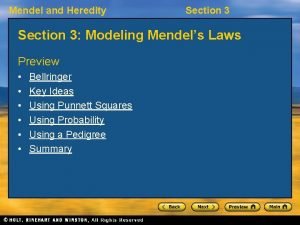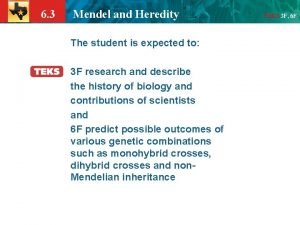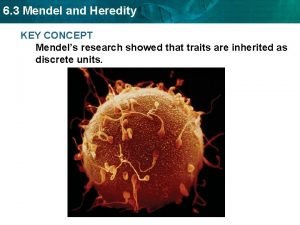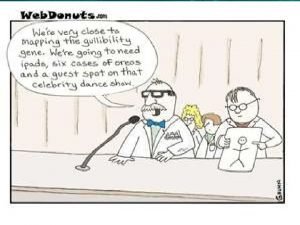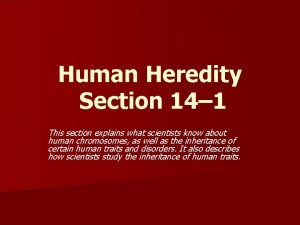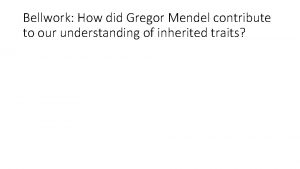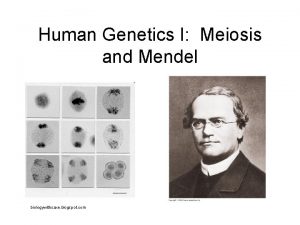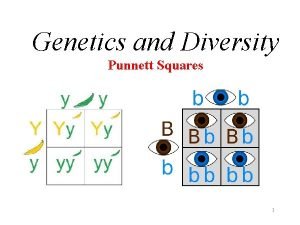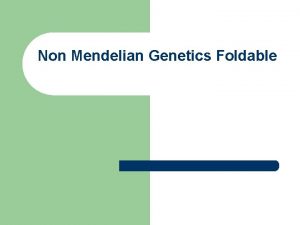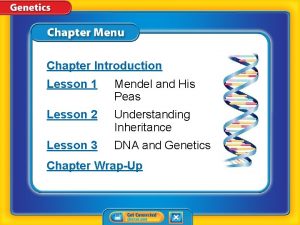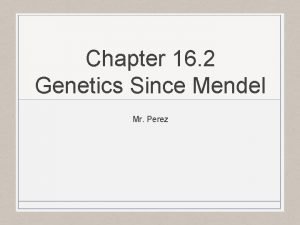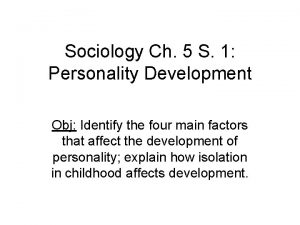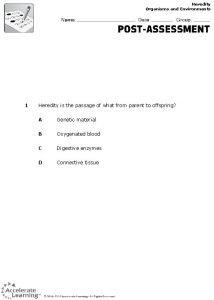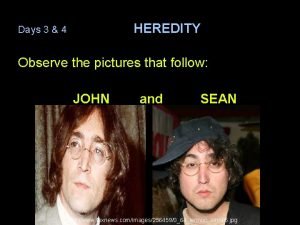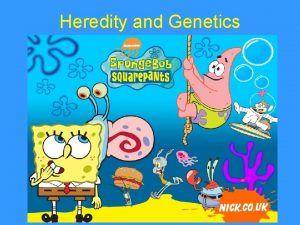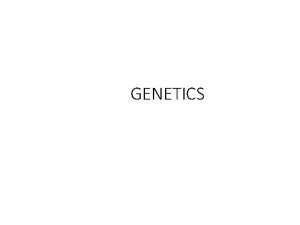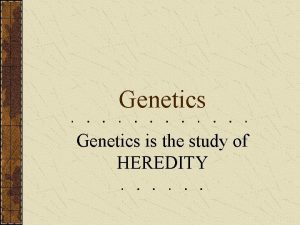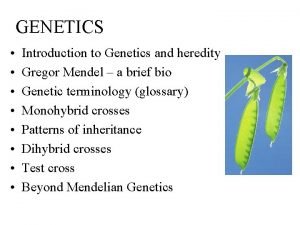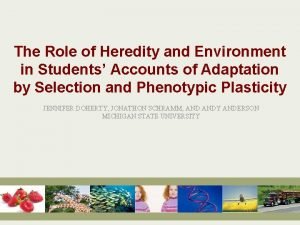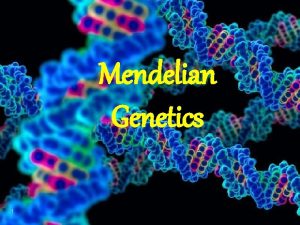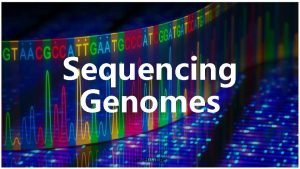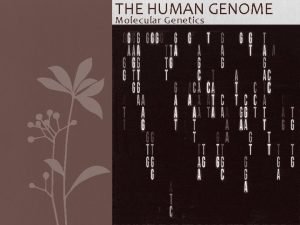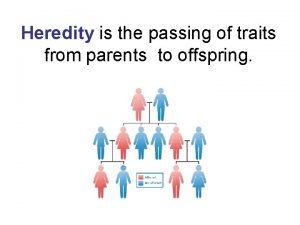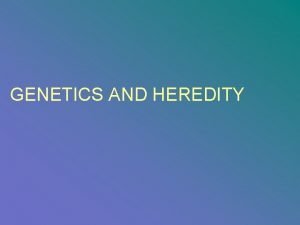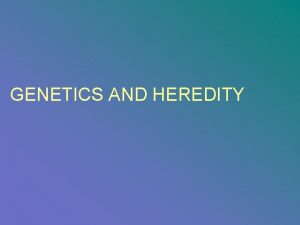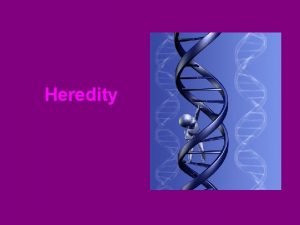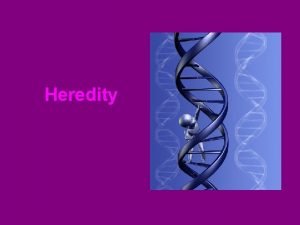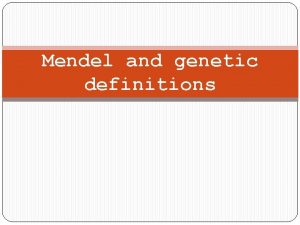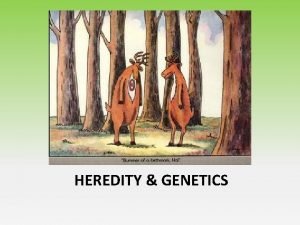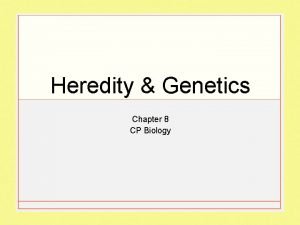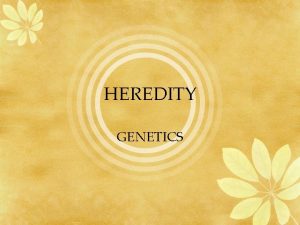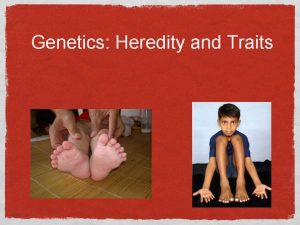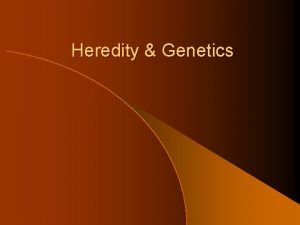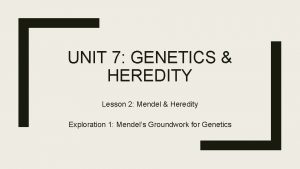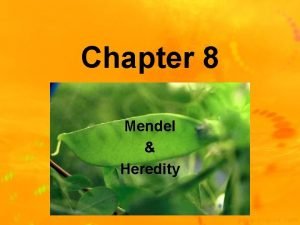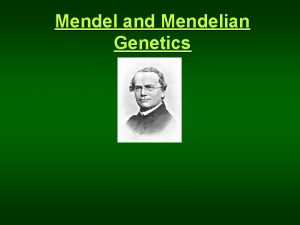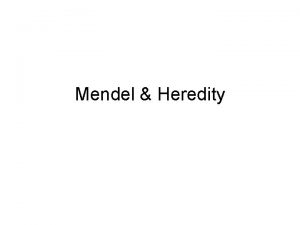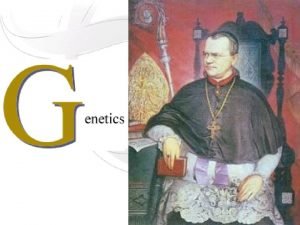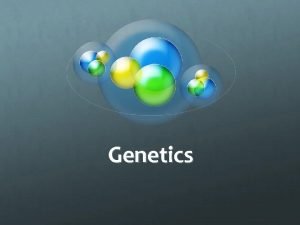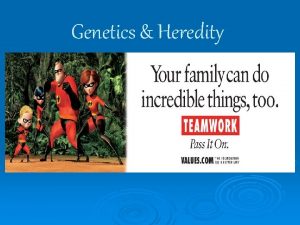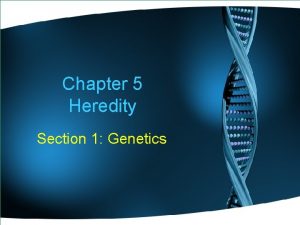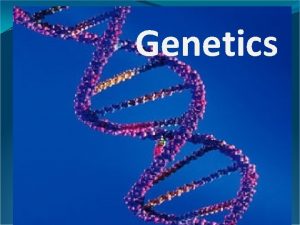Notes Genetics Mendel Human Genetics HonorsGifted Genetics Heredity



































- Slides: 35

Notes: Genetics Mendel & Human Genetics (Honors/Gifted)

Genetics & Heredity w What is genetics? n the science of heredity w What is heredity? n passing of traits from parents to offspring

Gregor Mendel w Austrian Monk interested in inheritance w Studied offspring from different “matings, ” or crosses, of pea plants. w He began his research with pea plants that were considered true-breeding. l Plants that have the ability to produce offspring identical to themselves, through the use of their own gametes = “Self-Pollination” = true breeding

Gregor Mendel w w w Most plants reproduce via cross-pollination, the combining of gametes from two separate plants. Mendel DID NOT want to have this extra variable in his research, so he prevented his plants from “self-pollinating” by crossing the pea plants himself. He began his research looking at 7 different pea plant TRAITS § a characteristic that varies from one organism to another

Mendel’s Research w All 7 traits Mendel studied occurred in one of 2 forms. w He cross-pollinated plants with different forms of the same trait (i. e. purple x white) to examine offspring.

After crossing these plants Mendel discovered that… 1. Inheritance is determined by genes. l Segments of DNA that determine a specific trait 2. Some alleles (different forms of a gene) are considered Dominant and some are Recessive: The Principle of Dominance. l l Dominant alleles that are expressed (usually capital letters) Recessive alleles that are hidden (usually lower-case)

His Experiments w Mendel conducted Monohybrid Crosses (mating involving only one pair of traits). n He cross-pollinated 2 pea plants with opposing traits n The original mating pair he used was called the Parental or P – Generation. l Ex Purple flowering plant & white flowering plant

Mendel - Monohybrid Crosses n n The offspring of this Parental cross is called the F 1 Generation, meaning “first filial. ” Results: ALL PLANTS’ FLOWERS WERE PURPLE!

Mendel – Monohybrid Crosses w Mendel’s 2 nd Experiment… n Mendel allowed the F 1 Generation (all purple) to self-pollinate. w Results: The F 2 Generation (“second filial”) produced flowers in a ratio of 3 purple: 1 white w This 3: 1 ratio occurred for each of the 7 traits in the F 2 Generations!

Alas…Mendel’s Conclusions 1) Every inherited trait has 2 copies of the gene – one from each parent. 2) There alternative versions of genes (alleles). 3) When 2 different alleles occur together, one can be completely expressed (dominant) while the other can be hidden (recessive). 4) Gametes (sperm and eggs) each carry one allele for a given trait; during fertilization, the offspring receives 1 allele from each parent.

Now let’s review some basic Terms… w Gene: Segment of DNA that determines a specific trait w Trait: a characteristic that varies from one organism to another w Allele: Different forms of a gene w Dominant Allele: an allele that hides a recessive trait; usually characterized by a capital letter. w Recessive Allele: an allele that can be “masked” or hidden by a dominant allele; usually characterized by a lower-case letter

Homozygous vs. Heterozygous w Homozygous: Offspring have two identical alleles (PP = homozygous dominant; pp = homozygous recessive); also known as “pure-bred” w Heterozygous: Offspring has one of each allele (Pp = heterozygous); also known as “hybrid”

Genotype v. Phenotypes w Genotype: the set/ combination of alleles an organism has for a certain trait…the “letters” (ex: PP, pp, or Pp) w Phenotype: the physical appearance of a trait in an organism…. the “looks” (ex: blonde hair) Genotype Phenotype

The Law of Segregation w 2 alleles for a trait segregate (separate) when gametes are formed; each offspring receives one trait from their parents

The Law of Independent Assortment w Alleles for different genes separate independently of each other during gamete formation. w One trait, like flower color, does not influence the inheritance of another trait, like plant height.

Probability & Genetics w Probability = the likelihood that a particular event will occur. w Principles of probability can be used to predict the outcomes of genetic crosses. w The more trials conducted, the closer the result will come to the EXPECTED ratio. w The Punnett square can predict the “probability” of outcomes resulting from a genetic cross.

Predicting Results: Punnett Squares w Punnett Squares are diagrams that use the Laws of Segregation and Independent Assortment to predict offspring w Possible gametes for 1 parent are placed along the top of the square; possible gametes for the other parent are written on the left of the square. w The genotypes are predicted by combining alleles R r from each parent. R RR Rr rr

For example… w We can use ratios to express genotypes and phenotypes. n Genotypic Ratio = ___ YY: ____ Yy : ___yy n Phenotypic Ratio = ____ yellow : _____ green

Predicting Results: Punnett Squares w Genotypic Ratio = 0 YY : 4 Yy : 0 yy 4 Yy or 100% Yy w Phenotypic Ratio = 4 yellow : 0 green 100% yellow

Predicting Results: Punnett Squares w Dihybrid crosses (crosses involving 2 traits) are a little more complex. w Possible combinations for the different types of alleles are placed at the top and sides of the square. w Example: (Round, Yellow) (wrinkled, green) Rr. Yy rryy Possible allele combos RY Ry r. Y ry ry Rr. Yy Rryy rr. Yy rryy

BEYOND DOMINANT & RECESSIVE ALLELES Part II:

Beyond Dominant & Recessive Alleles… w Some traits are Polygenic, meaning that more than one gene determine the phenotype. n Examples human hair color, eye color, weight, skin color

Incomplete Dominance w One form of a trait is NOT dominant or recessive to the other. Results in an “in-between” phenotype three different phenotypes are possible. w Example Four O’Clocks flower Red (RR) X White (WW) Pink (RW)

Co-dominance w When two dominant alleles are expressed at the same time in an offspring n Example: A homozygous red horse mates with a homozygous white horse to produce a horse with BOTH red and white hair (called a Roan coat).

BLOOD TYPES Part III:

Blood Types: A Result of Multiple Alleles – Genes with 3 or more possible alleles determining a trait n n Each individual receives only 2 alleles, but there are more than 2 in the population Example = Blood Type w Blood Phenotypes = A, B, AB, and O w Blood Alleles = IA, IB, and i w IA and IB are both dominant (codominant when together), & i is recessive


Blood Typing Chart Blood Type Possible Genotypes Can DONATE A ; AB Can RECEIVE Type A I AI A I Ai Type B IB IB I Ai B ; AB B; O Type AB I AI B AB Universal RECEIVER Type O ii Universal DONOR O A; O

Blood Type Frequency in Population

HUMAN GENETICS Part IV:

Human Genetics w Sex Chromosomes The two chromosomes that determine an individuals sex are XX (mom) or XY (dad). w Autosomal Chromosomes The other 44 chromosomes, not sex chromosomes w Karyotype = a picture of chromosomes arranged in 23 matching pairs; Sex chromosomes are ALWAYS on pair #23.

2 Types of Disorders w Sex-Linked Disorders w Chromosomal Disorders ***But first, let’s talk a little about Sex. Linked Traits…***

Sex-Linked Traits w All eggs carry an X chromosome w Females are XX; Males carry XY w In females, if a defective gene rides on one of the X chromosomes, the other X is likely to have a good copy of the gene that can take over for the “bad” gene w Males do not carry the backup copy of the X chromosome, so the gene is expressed

Sex-Linked Disorders w The information/ traits on the sex chromosomes are called sex-linked genes. Because these chromosomes determine sex, disorders caused by these genes are sex-linked disorders. Typically, these genes are found on the X chromosome. w Examples n n n Colorblindness Hemophilia Duchene Muscular Dystrophy

Chromosomal Disorders w Nondisjunction (failure of homologous chromosomes to separate) occurs during meiosis. The resulting individual has an abnormal number of chromosomes and that results in a disorder! w Examples: n n n Down Syndrome (Trisomy 21) Turner’s Syndrome (XO) sterile Klinefelter’s Syndrome (XXY)
 Section 3 mendel and heredity
Section 3 mendel and heredity Section 3 mendel and heredity
Section 3 mendel and heredity Section 3 mendel and heredity
Section 3 mendel and heredity Section 3 mendel and heredity
Section 3 mendel and heredity Section 3 mendel and heredity
Section 3 mendel and heredity Genetics is the study of heredity and variation
Genetics is the study of heredity and variation Chapter 17 the beginning of the life cycle
Chapter 17 the beginning of the life cycle Section 14-1 human heredity
Section 14-1 human heredity Chapter 11 human heredity section 11-3
Chapter 11 human heredity section 11-3 Chapter 11 complex inheritance and human heredity test
Chapter 11 complex inheritance and human heredity test Chapter 14 human heredity
Chapter 14 human heredity Pp
Pp Gregor mendel
Gregor mendel Gregor mendel’s principles of genetics apply to
Gregor mendel’s principles of genetics apply to How did gregor mendel contribute to genetics
How did gregor mendel contribute to genetics Meiosis
Meiosis Brown eyed father blue eyed mother
Brown eyed father blue eyed mother Mendel's genetics foldable
Mendel's genetics foldable Solid
Solid Genetics since mendel
Genetics since mendel Genetic vocabulary worksheet answer key
Genetic vocabulary worksheet answer key An unchanging, biologically inherited behavior pattern.
An unchanging, biologically inherited behavior pattern. Heredity concept map
Heredity concept map Heredity is best described as
Heredity is best described as Pictures of heredity
Pictures of heredity Allele
Allele Heredity
Heredity ____________ is the study of heredity.
____________ is the study of heredity. Homozygous
Homozygous Chromatids
Chromatids Role of heredity
Role of heredity Heredity terminology
Heredity terminology The basic units of heredity
The basic units of heredity Heredity torrent
Heredity torrent Heredity
Heredity Heredity
Heredity
